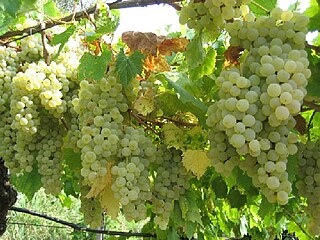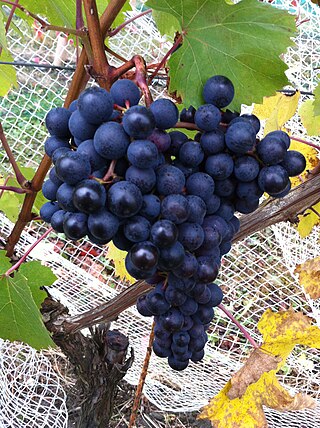
Aramon or Aramon noir is a variety of red wine grape grown primarily in Languedoc-Roussillon in southern France. Between the late 19th century and the 1960s, it was France's most grown grape variety, but plantings of Aramon have been in continuous decline since the mid-20th century. Aramon has also been grown in Algeria, Argentina and Chile but nowhere else did it ever reach the popularity it used to have in the south of France.

Marzemino is a red Italian wine grape variety that is primarily grown around Isera, south of Trentino. The wine is most noted for its mention in the opera Don Giovanni of Wolfgang Amadeus Mozart. The vine ripens late and is susceptible to many grape diseases including oidium. Wine produced from the grape has a characteristic dark tint and light plummy taste.

Durella or Durello is a white Italian wine grape variety originating from the Veneto wine region of northeast Italy. Today it is sparsely cultivated, though some producers like to experiment with it since its high acid levels makes it suitable for sparkling wines.
Verduzzo is a white Italian wine grape grown predominantly in the Friuli-Venezia Giulia region of northeast Italy. It is also found in significant plantings in the Piave Denominazione di origine controllata (DOC) of the Veneto region, though some of these plantings may be of the separate Verduzzo Trevigiano variety. Verduzzo Friulano is used in varietal and blended wines, many of which fall under DOC as well as vino da tavola designations, that range in style from dry to late harvest wines. According to wine expert Oz Clarke, most of the sweeter examples of Verduzzo can be found in the Friuli-Venezia Giulia with the grape being used for progressively drier styles of the wine the further west into the Veneto.

Duriense is a Portuguese wine region covering the same area as the Douro DOC and the Port wine region. In difference from Douro DOC, Duriense VR is a designation at the lower Vinho Regional (VR) level, which corresponds to table wines with a geographical indication under European Union wine regulations, similar to a French vin de pays region. Thus, it is the simpler or less typical wines of the Douro region that are sold using a Duriense VR label.

Incrocio Manzoni or Manzoni grapes is a family of grape varieties named after Professor Luigi Manzoni (1888-1968) of Italy's oldest school of oenology located in Conegliano, in the Veneto region. Manzoni created the new grape varieties by selecting, crossing and grafting vines from various vineyards during the 1920s and 1930s. The family includes both white and red grape varieties. Although most Manzonis are grown in northeastern Italy, they are mainly grown in the Piave area of Province of Treviso and are only now starting to be sold commercially in Europe and the United States.
Verduzzo Trevigiano is a white Venetian grape variety that is grown in the Eastern Veneto wine area. In the past the name Verduz referred to a wide range of grape varieties in the Venetian area. By the descriptions found, they were often morphologically very different, but shared the character of late ripening. However we can very frequently find the name Verduzzo in the ampelographic list of the 19th century, there is not any sign of this Verduzzo until the beginning of the 20th century. At that time just two varieties, with the same name Verduzzo, were still cultivated in the Veneto and Friuli area, they were what we today call Verduzzo Friulano and Verduzzo Trevigiano. The two varieties are clearly different, as demonstrated even with DNA profiling analyses in 2010 and 2011. However at the beginning of the 20th century, the two Verduzzo were called with the same name and often were present in the same vineyard and made wine together. Cosmo proposed to call the two varieties with different names: Verduzzo friulano for the varieties typical of Ramandolo production that was the only one present in that area of Friuli, and Verduzzo Trevigiano for the other one, that was present in the oriental zone of Veneto, where even Verduzzo friulano was spread, but which has a sure origin in the Treviso province how showed by the papers of Lepido Rocco.
Albaranzeuli bianco is a white Italian wine grape variety that is grown primarily in Sardinia. Ampelographers use to believe that the grape was originally Spanish in origin and was introduced to the island when it was ruled by the Crown of Aragon. Recent DNA profiling has suggested that the grape may have originated on the island as a crossing between the red Sardinian wine grape Girò and the Spanish table grape Molinera, known locally as Pansa Rosa di Málaga and distinct from the Veneto wine grape Molinara that is used in Amarone. A pink skinned grape known as Albaranzeuli nero is also found in Sardinia but its exact relationship to Albaranzeuli bianco is not yet clear.
Albarossa is a red Italian wine grape variety that was created in the Veneto wine region in 1938 by grape breeder Giovanni Dalmasso at the Istituto Sperimentale per la Viticoltura in Conegliano. Dalmasso originally thought he created the grape from a crossing of Nebbiolo and Barbera but DNA profiling in 2009 confirmed that the "Nebbiolo" vine used wasn't Nebbiolo at all but rather a very old French wine grape variety from the Ardèche, Chatus. The confusion stemmed from a synonym of Chatus, Nebbiolo di Dronero.
Béquignol noir is a red French wine grape variety that originated in Southwest France. However it is now more widely grown in the Mendoza wine region of Argentina where it is often used to add color to blends. The grape is often confused with several other red wine varieties such as Cabernet Franc, Durif, Fer and Prunelard with Béquignol noir sharing several synonyms with these grapes. However DNA profiling has shown Béquignol noir to be distinct from those grape varieties. Further research in 2011 showed that Béquignol noir may have a parent-offspring relationship with the Savagnin grape.
Gueuche noir is a red French wine grape variety that has been historically grown in the Franche-Comté of eastern France but is now close to being extinct. Though its exact relationship has not yet been determined by DNA analysis, ampelographers believe that the grape variety is closely related to the Hunnic grape Gouais blanc which is notable for being the mother vine to several grape varieties including Chardonnay and Gamay. There also might be a relationship between Gueuche noir and the Jura wine grape Enfariné noir.

Arrouya noir is a red French wine grape variety grown in the Jurançon region of Southwest France. The grape has a long history in the region, growing in the Pyrénées-Atlantiques since at least the late 18th century. Ampelographers believe that Arrouya noir has some genetic relationship with Camaraou noir, Fer and Petit Courbu though the exact nature of those relationships is not yet known. The variety also shares some similarities in morphology with Cabernet Franc and until the late 19th century was often confused for the Loire and Bordeaux wine grape, especially in the Basses-Pyrénées and Hautes-Pyrénées region.
Manto negro is a red Spanish wine grape variety grown on the Balearic islands. It is used in wines produced under the Binissalem-Mallorca and Plà i Llevant (DO) Denominación de Origen (DO)s, as well as the Illes Balears appellations. Today, Manto negro is almost exclusively found on the island of Majorca with 320 hectares, making it the most widely planted grape variety on the island. It represents over 20% of the total vineyard land in production. Although planted throughout the island, the vine seems to be more successful in the rocky soils of the western Binissalem region.

Valentino nero is a red Italian wine grape variety that is grown in the Piedmont wine region of northwest Italy but was initially bred at the Conegliano research center in the Veneto. In 1936, its creator, Giovanni Dalmasso, stated that the grape was a crossing of two Vitis vinifera Piedmontese varieties, Nebbiolo and Dolcetto, but DNA profiling in 2009 showed that the French wine grape Chatus and Dolcetto were the parent vines.
Arilla is a white Italian wine grape variety that is grown on the island of Ischia in the Tyrrhenian Sea near the Gulf of Naples. However, despite being exclusively found on the island, ampelographers believe that the grape may have actually originated in Sicily.
Avarengo is a red Italian wine grape variety that is grown in the Piedmont wine region of northwest Italy where it is a permitted blending component in the Denominazione di origine controllata (DOC) wines of Pinerolese. Here the grape is usually blended with Avanà, Neretta Cuneese and other local red Piemontese varieties.
Bianchetta Trevigiana is a white Italian wine grape variety that is grown in the Trentino-Alto Adige/Südtirol and Veneto wine regions of northeast Italy. Here the grape is rarely used a varietal but, instead, is a permitted blending grape adding acidity to the wines of several Denominazione di Origine Controllata (DOC) zones including the sparkling wine Prosecco and has also been used for vermouth production. The name Trevigiana is derived from the province of Treviso where the grape is believed to have originated from.
Bigolona is a white Italian wine grape variety from the Valpolicella region of northeast Italy where it has been growing since at least the early 19th century. The wine has traditionally been used in the production of late harvest and botrytized dessert wines with the grape's synonym Smarzirola being derived from the Italian marcire meaning "to rot".

Trebbiano d'Abruzzo is the most important white wine grape in Abruzzo.








